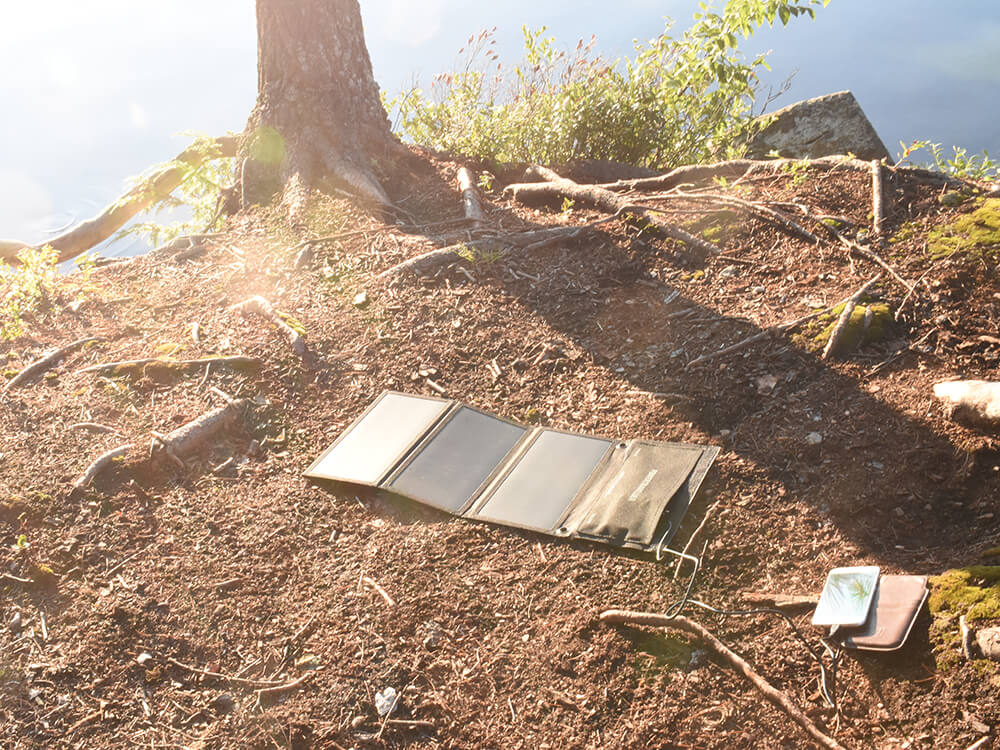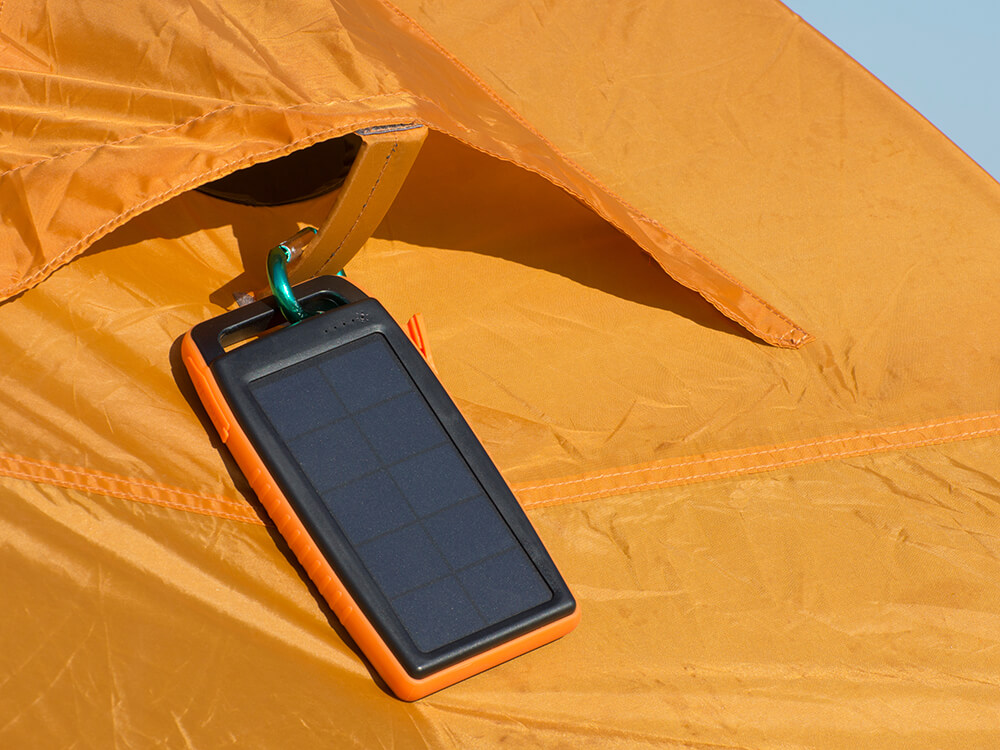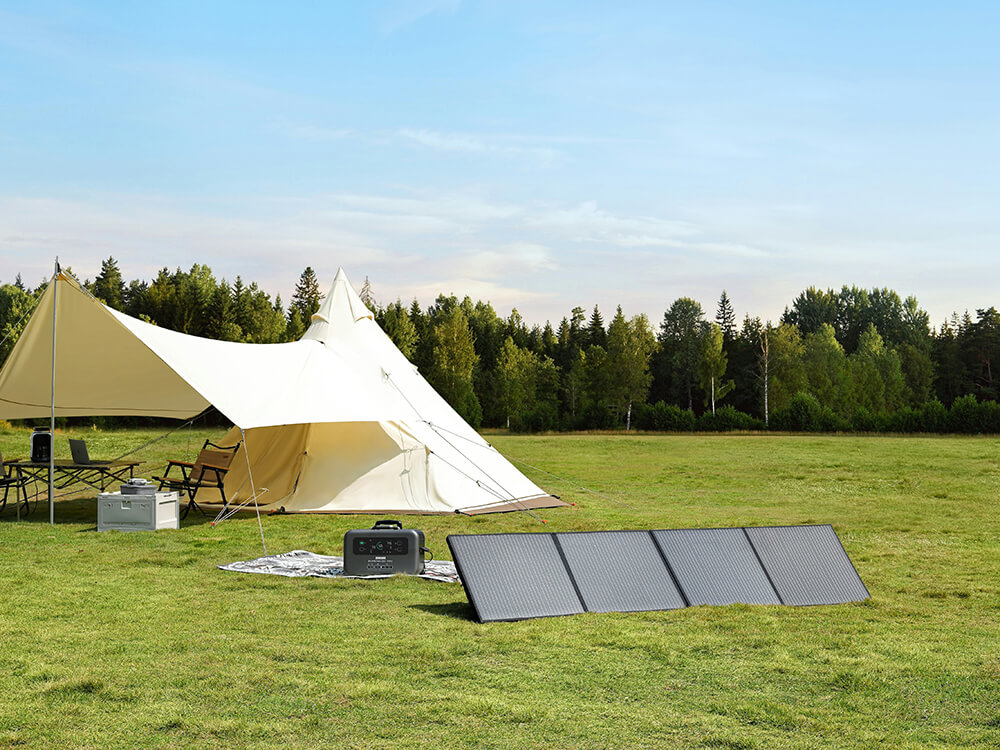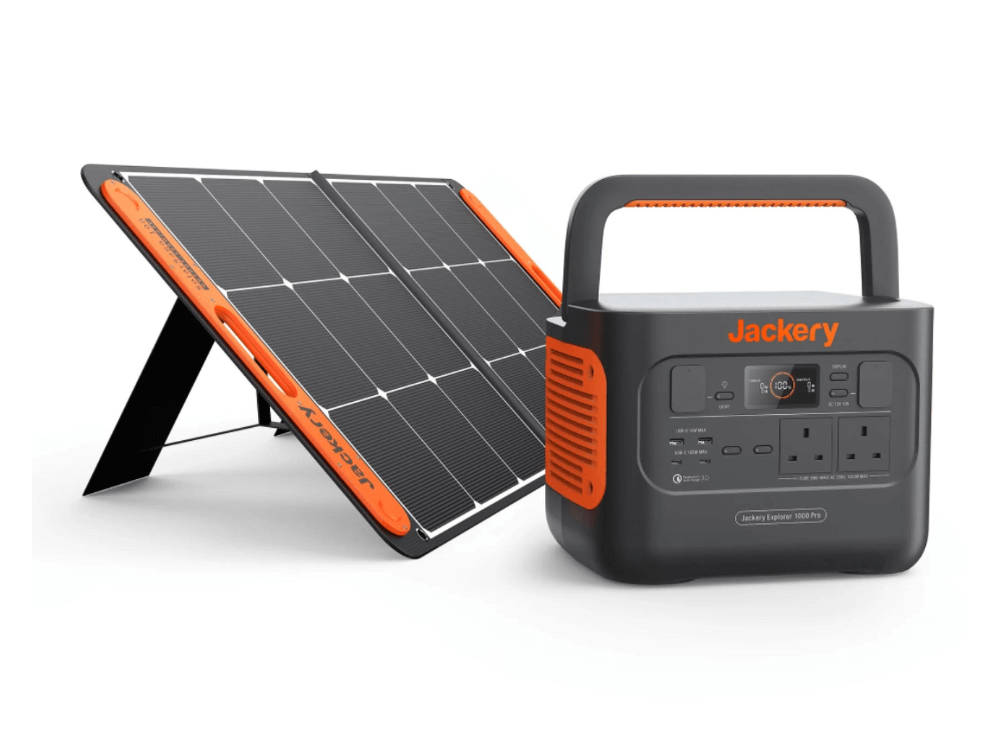Solar power for camping: all you need to know
Solar power is nothing new – it's been drying clothes for millennia and does a good job of turning my house porch into a tomato factory (should that be 'plant'?)
Gathering and storing that solar power to be used for charging batteries and powering lights is a relatively recent phenomenon, though. While we mainly think about solar power in terms of farmers' fields being converted into giant solar farms, portable chargers harvesting the sun’s rays to recharge your phone have existed for a few years and the technology is improving.
Can you rely on a solar charger to keep your devices topped up on the campsite, though? Are they proficient enough to leave other chargers behind? This is our guide to solar power for camping.
Page contents
- What are portable solar chargers?
- How powerful are portable solar chargers?
- How reliable is solar power for camping?
- The best solar chargers for camping
- About our magazines
Words by Jack Hart and Iain Duff
What are portable solar chargers?

Back in 2018, I went hiking in Canada and ended up miles from any other person, let alone a building.
We took a portable solar charger with us, consisting of a folding solar panel that your devices could plug directly into. In that situation, it seemed like a slam dunk move: we would be away from any source of power for days, so a simple solar panel clipped onto a rucksack or tent, soaking up sunlight, would keep our phones topped up for emergencies.
A bright idea, perhaps, but it didn’t work.
The portable solar charger in question couldn’t handle the balmy Canadian heat in August, short-circuiting and leaving us out of battery. For a first experience with solar chargers, it didn’t exactly fill us with confidence.
In the past six years, though, it looks like technology has advanced to the point where portable solar chargers are more reliable and have worked their way into the rucksacks of most wild campers and lightweight trekkers. Even if you’re not planning on hiking into the great unknown, having an extra source of power while camping will save you needing to walk to the local café to charge your phone.
Most solar chargers will feature multiple output options, ranging from USB and USB-C ports for smaller chargers and mains outputs for larger generators.
How powerful are portable solar chargers?

Solar chargers for camping need to be portable, either stashing into a rucksack to be carried on hiking trips or folding neatly to be stored in a car or campervan. The size of charger you pick will determine how powerful it is and what kind of devices you can charge.
Editor of Camping, Iain Duff, has a Freeloader iSIS, which claims to charge a mobile phone three times over on a single battery, ample for a weekend’s trip to the great outdoors. It’s also a small, highly portable solar charger, weighing just 240g and packing easily into a rucksack.
If your devices need a bit more juice, you could opt for something like the SolarPowa 28 from BigBlue, which unfolds from a canvas case to reveal four solar panels – a pretty standard design for portable solar chargers and one that is proven to harvest enough sunlight for several devices, including laptops. This kind of charger can usually be fixed to a rucksack or the outside of a tent, too.
Need even more power?
You can always pick up something like the Crafuel Solar Generator 600W, which can charge 10 devices simultaneously, including 12V devices like kitchen appliances and DIY tools. The trade you make for that power is the size of the charger, which includes a large solar panel and separate generator, so it’s definitely one for car camping rather than lightweight trips to the great outdoors.
How reliable is solar power for camping?

As detailed above for our time hiking in Canada, it’s best not to rely on solar power as your only source of electricity – if you can stash an additional, pre-charged power bank in your rucksack, you’ll be prepared in case the charger fails or the clouds gather.
Which, of course, is the biggest obstacle to using a solar charger while camping.
Particularly in the UK, poor weather can mean that devices which on paper should hold enough juice to charge several laptops can struggle to power a single phone. Performance in cloudy conditions will vary from device to device.
If you need a reliable source of power while camping, a larger portable solar charger with the panels disconnected from the generator will usually collect more sunlight, particularly when clouds gather. A smaller charger, particularly one with a single solar panel, will struggle to harvest enough sunlight to keep even small devices charged.
This is why solar chargers feature a mains or USB input, so that you can top them up on rainy days. Of course, this does slightly defeat the point of having a solar charger…
In short, the bigger (and more expensive) your solar charger is, the more you can rely on it to perform no matter the weather.
The best solar chargers for camping
Listed below are some of our favourite portable solar chargers, including a range of options depending on what type of camping you’re keen on, from super lightweight wild camping to packing the car full of every bit of kit imaginable!
EcoFlow 160W Solar Panel
Unfolding to reveal four solar panels that together deliver 160W, this portable solar charger from EcoFlow (a brand with impressive off-grid energy credentials) is designed to perform well in poor weather. It features an IP68 waterproof rating and the panels are encased in protective ETFE film, which means the device is protected from wind, rain and dirt.
Even better, this solar panel folds into a neat pack that measures 42cm by 68cm by 2.4cm, stashing easily into your car or tent when not in use.
EcoFlow 160W Solar Panel
.png)
Description
This large portable solar panel will ensure that you never run out of power while pitched up at the campsite, delivering a massive 160W of power.
Protected by ETFE film and a high IP resistance level, this solar panel can handle rough conditions, from dry and dusty ground to wet weather.
Pros & cons
- Good
- Huge power output
- Weatherproof
- Fast charging
- Bad
- Large design
- More than most campers need
Specifications
- Weight: 7kg
- Dimensions: 157cm by 68cm by 2.4cm
- Operating temperature: -20°C to 85°C
- Output: 160W
BioLite SolarPanel 5+
Featuring corner latches to attach to your rucksack or tent, the SolarPanel 5+ is ideal for campers heading off the beaten track and needing a reliable source of power for phones, headtorches and other gadgets.
Its ultra-slim panels are just 6.6mm deep and fold together to reduce space when not in use, delivering 10W per hour during peak sunlight hours. BioLite has engineered the SolarPanel 5+ to capture as much sunlight as possible, using an integrated sundial to align with the sun and a 360-degree kickstand for optimal positioning on uneven ground.
BioLite SolarPanel 5+
.png)
Description
Providing a functional 5W output, the SolarPanel 5+ from BioLite is ideal for solo campers needing to recharge their phone or similar devices.
The 3,200mAh battery stores energy for later and the integrated kickstand helps you to find the optimal position in sunlight on uneven ground.
Pros & cons
- Good
- Small, portable design
- Integrated battery
- Optimised charging
- Bad
- Not weatherproof
- Limited power output
Specifications
- Weight: 0.5kg
- Dimensions: 26cm by 21cm by 2.5cm
- Output: 5W
Goal Zero Nomad 5
This is one of the smallest portable solar chargers around, measuring just 34cm tall, so it’s ideal for solo camping trips. The built-in kickstand allows you to find the best position for the Nomad 5 to harvest as much sunlight as possible, delivering that power to your devices through a 5V USB output.
We wouldn’t recommend using the Nomad 5 in anything but bright sunny conditions as it’s not been designed for use in all weathers, but for a summer camping trip where you don’t need loads of power, it’s a good option.
Goal Zero Nomad 5
.png)
Description
This lightweight solar panel is ideal for solo adventurers, providing a serviceable 5W output (great for mobile phones and similar devices) and encased in a rugged outer layer.
The Nomad 5 from Goal Zero delivers power from a universal USB port and features a built-in kickstand for optimised sunlight collection.
Pros & cons
- Good
- Small, portable design
- Integrated kickstand
- Rugged outer later
- Bad
- Limited power output
Specifications
- Weight: 360g
- Dimensions: 24cm by 17.8cm by 2.8cm
- Output: 5W
BigBlue 14W SolarPowa
Designed primarily for 5V devices like phones and power banks, the SolarPowa solar charger from BigBlue is good value for money, providing a steady 5V output from four solar panels that fold down into a pack smaller than a regular tablet.
The panels themselves are waterproofed by a polymer surface, with a rugged fabric casing around the whole charger to keep it protected from knocks and scrapes within your rucksack.
BigBlue 14W SolarPowa
.png)
Description
Unfolding to reveal four solar panels, the 14W SolarPowa from BigBlue is a highly portable solar charger, encased in a tough canvas case.
BigBlue's SolarPowa series boasts an energy conversion of 24%, 9% higher than the industry average, which means your devices will stay powered no matter the weather.
Pros & cons
- Good
- Highly portable design
- Rugged canvas case
- 24% energy conversion
- Bad
- USB port does not connect to all devices
Specifications
- Weight: 360g
- Dimensions: 14.5cm by 64cm by 0.5cm
- Output: 14W
Jackery Solar Generator 1000 Pro
Looking for something more powerful? Look no further than the 1000 Pro version of Jackery’s Solar Generator, offering a massive 1,000W output from multiple output ports, including USB-C, 100W PD and 1,000W AC.
The external waterproof solar panel connects to the generator, which can power a huge range of appliances and functions in temperatures as low as -40 degrees C. Even better, the battery inside the generator has a lifespan of 10 years continuous use, so you can rely on this solar charger again and again.
Jackery Solar Generator 1000 Pro

Description
Delivering a massive 1,000W output, this solar generator from Jackery is a great option for large families heading on longer camping trips.
The large solar panels connect to an external generator, from which you can charge a wide range of appliances and devices from USB ports, a mains output and more.
Pros & cons
- Good
- Huge power output
- Connects to many devices
- Rapid set-up
- Bad
- Difficult to carry
Specifications
- Weight: 11.5kg
- Generator dimensions: 34cm by 26cm by 25cm
- Solar panel dimensions: 122cm by 53cm by 2.5cm
- Output: 1,000W
Expert Camping advice!

Camping magazine has been the voice of campers for over 60 years!
Camping is the UK's only magazine devoted to the wonderful world of life under canvas and the freedom it brings.
Every issue is packed with inspirational travel, the top camping sites to stay on, reviews of the latest tents, camping gear reviews, practical help and much more to help you get the most out of your camping adventures.
Want to know more about Camping magazine?
About Camping magazine







Recent Updates
10 epic hacks to make camping easier
These hard-learned hacks from Camping Editor, Iain Duff, will make your camping experience easier and more comfortable - submit your own for a chance ...
Camping for beginners: our complete guide
If you’ve never pitched up before, this is where you need to start: our complete guide to camping for ...
Tent repair and maintenance: our guide to caring for camping gear
If you look after your tent, it will look after you – these simple tips will keep your tent in top condition ...
The top 12 long-distance walks in the UK
Hiking and camping go hand in hand, which makes long-distance walks a favourite of campers – this is our pick ...
Camping barbecue: our guide to cooking up a storm this summer
Is there anything more British than sausages grilled on an open flame and dropped on wet grass? Camping and ...
Our family camping checklist: everything you need to pack
Sure, you’ve packed the tent and the sleeping bags – but what about slip-on shoes and glow sticks? These are ...
Our guide to planning the perfect camping road trip
Roll down the window, pop on those shades and crank up the volume – it’s time for a road trip. Get ready for ...
Camping in Europe: our 12 top tips
If you’ve not camped in Europe before, there’s a few tips and tricks you’ll need to avoid some continental ...
Wild camping kit list: everything you need for your next adventure
Make sure you’re ready for anything with this list of lightweight camping gear and clothing, including ...
Camping furniture: all you need to know to make your tent a cosy haven
We delve into the essentials of camping chairs, camping tables, and kitchen and bedroom furniture, ensuring ...
Other Articles
Camping lights for tents: What you need to know
We will guide you through all the lighting options available for you and your tent, including interior lighting, torches, lanterns, light kits and ...
Camping kitchen: all you need to know
In the great outdoors, a well-equipped camping kitchen transforms mealtime into a delightful adventure ...
How to pack away your camping gear for winter
A complete guide to packing and storing your gear at the end of the season ...
Camping guide to trailers
Trailer stash or trailer trash? Being able to carry lots of other gear when you go camping isn’t such a bad ...
Winter camping: all you need to know to keep warm
Winter doesn’t have to mean the end of the camping season. With good preparation and the right gear, there’s ...
Camping toilets: a complete guide
If you are wild camping, camping off-grid or the campsite you book onto doesn’t have toilet facilities, you ...
Top tips for camping in windy weather
How to make sure your tent stands up to gusty conditions ...
Camping tents: a complete guide
If you're considering buying a camping tent, whether it's your first time or you're a seasoned camper, making ...
Camping sleeping bags and beds: a complete guide
When it comes to camping, there's one essential item that can make or break your outdoor adventure: the ...
Camping gas: how to use gas on the campsite
A complete guide to using camping gas appliances safely on the campsite, from choosing the right stove to ...